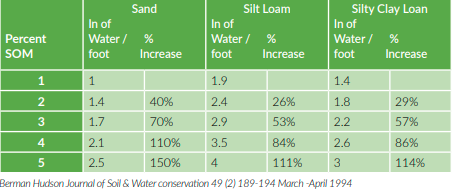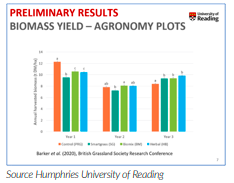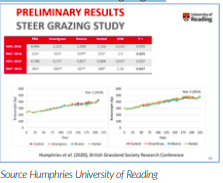Written by William Waterfield from The Farm Consultancy Group
Open just about any agricultural journal and one is bombarded by stories about regenerative agriculture but why all this interest? The confusion surrounding the subject is compounded by terms such as holistic management circular systems, closed production cycles, conservation agriculture, agroecological systems, enterprise stacking, agroforestry, mob grazing, herbal leys or new business models and that is before one starts to consider terms such as mycorrhizal fungi, liquid carbon pathways, rooting zones and the plethora of techy geek speak that surrounds just about any subject these days.
So, what is Regenerative Agriculture? two definitions sum up the situation. The first from Robert Rodale the son of the founder of the Rodale Institute in the United States defines it as “A holistic approach to farming that encourages continuous innovation and improvement in environmental, social and economic measures.” The second from Gabe Brown a US farmer from North Dakota who defines it “regenerative agriculture is a renewal of the food and farming systems which aims to regenerate the topsoil, increase biodiversity, improve the mineral carbon and water cycles whilst improving profitability throughout the supply chain.”
These two definitions clearly show that regenerative agriculture can be more than just about the farming practises that are being carried out. It is a systems approach to agriculture and the food supply, encompasses the whole food system highlighting the broken and linear nature of the current supply system. One which is dominated by a few multinational players and loses any connection back to the farm and the impact that the current system is having on the whole eco system that we depend on.
At the heart of regenerative agriculture is the understanding that we are all dependent on the top few inches or centimetres of soil on this planet. That we have failed to grasp how important it is to look after this finite resource, ensuring that the whole production cycle uses less finite resources and becomes more efficient whilst ensuring that the benefits from this are better shared by all the stakeholders including consumers.
As Robert Rodale put it it’s a continuous learning process, one that is based on the fact that the only free source of energy is sunlight and that plants alone can harvest it. When we focus on this it becomes obvious that we need to understand the role that plants above and below ground play in this process and how we as farmers can help to maximise this biological process.
Approximately half a plant’s dry matter is below ground and until recently out of mind, however without the roots and their connections the system clearly falls down. Understanding what goes on below ground and how this drives the whole above ground system is key to agriculture. The below ground eco system is hugely complex and only recently becoming understood, in that there is greater species diversity in a teaspoon of soil than there is in a rain forest. To put it simply, plants exchange some of their photosynthetic gains (sugars and carbohydrates) with the eco system below ground in return for the essential nutrients that the plant needs to grow and survive and in so doing build organic matter.
Table 1 Organic Matter and Available Water

Why is Soil Organic Matter Important?
Increasing soil organic matter has four major benefits some of which may sound contradictory:
• Improved water holding capacity
• Improved cation exchange capacity (nutrient holding)
• Better soil structure (drainage)
• Carbon sequestration
The farmer’s role therefore starts with the aim of ensuring that the below ground eco system is happy, healthy and productive. This is the core of Regenerative Agriculture and upon this the whole system can be built. The critical components required by productive below ground communities are that they are not disturbed (reduce cultivation), they have a continuous source of food (continuous above ground plants cover), that they perform best when they are very diverse and are not upset by large dollops of inorganic material. Sounds simple doesn’t it, but does regenerative agriculture work? Let’s start by looking at some of the claims for organic matter.
One of the major claims for organic matter is that the more you have the more drought tolerant your soils. Table 1 below from way back yonder shows that simply increasing soil organic matter by 1% increases its water holding capacity by 30 – 40%
One of the fundamental tenants of regenerative farming is that it’s the farming practices that influence the level of organic matter in the soil. Table 2 show the results from four neighbouring farms in North Dakota US which we can assume have broadly similar soil types but different farming system. We can see that Farm 4 is the only one who has significantly higher level of soil organic matter but combines all the elements as well as livestock. That’s great but it doesn’t confirm that the organic matter has any effect on the availability of nutrients. Table 3 is from the same four farms and shows the level of the three major nutrients plus the level of water extractable organic carbon which is an important component in the soil food web. Here again the high organic matter soil has higher levels of available nutrients.
Carbon Sequestration
It’s widely claimed that the soil can help to lock up carbon and that agriculture and forestry can be part of the solution to global warming. Looking at the level of carbon in the soil after a number of years we see that the farming system has a major influence and after just 5 years the level of carbon is significantly higher than on the traditionally managed farms. At this point the question that is usually asked is does it work – economically and productively? To fairly assess the full impact of regenerative practices we need to consider the effect that the alternative (conventional system) is having, be it on the environment or water quality and whilst this data is available it’s beyond the scope of this article.
Table 2 Organic Matter and Farm System

Table 3 The Effect of Soil Organic Matter on Available Nutrients

Table 4 Farming System and Soil Sequestration of Carbon

The Economics of Regenerative Agriculture
A systems approach such as regenerative agriculture demands that we should start looking at the whole system or at least all the component parts of the system. Approaches that only counts the £ of income or the gross margins are no longer any good. Many would argue that we let ourselves down if we do not consider the true costs. We as farmers impose costs on those down stream from us be that water companies or the natural environment.
In accounting for our activities, we have to start somewhere and accepting that you can’t be green when your accounts are in the red and therefore counting the pennies is probably a good place to start. Many arable farmers who have moved into regenerative agriculture via direct drilling route will have seen a release of capital from machinery no onger required to be replaced by a very expensive direct drill. At the same time substantial savings in overhead costs with lower labour, machinery repairs and reduced fuel bills.
For livestock farmers, a move towards a more grazing based system results in a reduction in feed costs and when accompanied with outwintering substantial reduction in capital as well as lower running costs. With improving soil organic matter and the associated increase in available nutrients, a reduction in fertiliser costs in nitrogen where annual reduction of at least 10% are achieved on many arable units. Looking at the specific performance data from some of the trials it is clear that the expected benefits in terms of additional dry matter are achieved as illustrated by both the work at University of Dublin and the University of Reading.
Graph 1 Defoliation and yield of 5 sward types

In terms of production one can consider the yield of dry matter. Work at the University of Dublin has shown that diverse leys with seed mixtures consisting of 40% Grass 30% Legumes and 30% Herbs with no artificial nitrogen out yielded ryegrass only swards receiving 250 Kg of Nitrogen by 500kg per hectare.
Graph 2 Biomass Yields from 4 sward types over three years

Closer to home, work at the University of Reading over a three year period has shown that the greater the diversity in the mixture resulted in increased yield. As years progress in a challenging dry season the effect of drought on PRG only sward was dramatic.
Graph 3 The effect of sward type on Lamb growth

A second experiment at UC Dublin compared five swards with actual or simulated grazing. Again, this showed that the two diverse swards out yielded mono cultures. In terms of animal performance lambs of diverse swards were shown to be 2.4 kg heavier over the trial period compared to perennial ryegrass only swards. At the same time the lambs on diverse swards needed less anthelmintic treatments.
Graph 4 Animal performance across a range of sward types
Proving the economic benefits under trial circumstances is more of a problem. The preliminary results from Reading with a group of Friesian steers showed that the sward diversity was converted into increased liveweight gain.

So, to answer the question in the title of this blog: No regenerative agriculture is not a passing fad but a system of agriculture that is truly sustainable with the potential benefits for consumers and the wider environment. At the same time, it can allow farmers to diverse their systems adding value or new enterprises.
